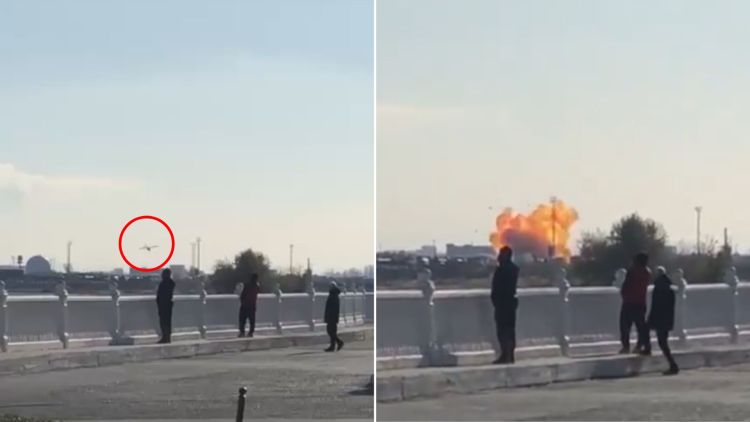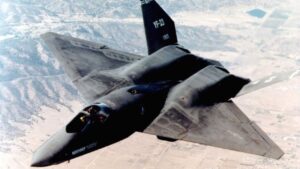Ukraine, in a bold and unprecedented move, struck Russian warships in the Caspian Sea on Wednesday, November 6, marking the first time Kyiv’s forces have targeted this distant and heavily fortified naval base.
This strike, more than a thousand kilometers from Ukraine’s borders, showcases the growing reach and capability of Ukraine’s military, particularly with its long-range arsenal.
Let’s quickly break down what happened, why it matters, and how it could shift the dynamics in the ongoing war against Russia.
The Strike: A Bold New Frontier
The target of this daring operation, according to reports, was the port city of Kaspiysk in Dagestan, home to Russia’s Caspian Flotilla.
According to Ukrainian intelligence, the strike hit two Gepard-class missile frigates, Tatarstan and Dagestan. These ships aren’t just small players in Russia’s naval game—they’re equipped with Kalibr cruise missiles, the same weapons that have been used to rain destruction on Ukrainian cities.
Footage shared by Ukrainian officials appears to show one of their kamikaze drones diving toward its target, with antiaircraft fire lighting up the sky in a desperate attempt to fend off the attack.
While Russia claims to have intercepted one drone, Ukrainian sources suggest that both frigates were damaged.
What makes this strike particularly significant is its distance.
Ukraine, in a bold and unprecedented move, struck Russian warships in the Caspian Sea on Wednesday, November 6, marking the first time Kyiv’s forces have targeted this distant and heavily fortified naval base.
This strike, more than a thousand kilometers from Ukraine’s borders, showcases the growing reach and capability of Ukraine’s military, particularly with its long-range arsenal.
Let’s quickly break down what happened, why it matters, and how it could shift the dynamics in the ongoing war against Russia.
The Strike: A Bold New Frontier
The target of this daring operation, according to reports, was the port city of Kaspiysk in Dagestan, home to Russia’s Caspian Flotilla.
According to Ukrainian intelligence, the strike hit two Gepard-class missile frigates, Tatarstan and Dagestan. These ships aren’t just small players in Russia’s naval game—they’re equipped with Kalibr cruise missiles, the same weapons that have been used to rain destruction on Ukrainian cities.
Footage shared by Ukrainian officials appears to show one of their kamikaze drones diving toward its target, with antiaircraft fire lighting up the sky in a desperate attempt to fend off the attack.
While Russia claims to have intercepted one drone, Ukrainian sources suggest that both frigates were damaged.
What makes this strike particularly significant is its distance.
The Caspian Sea lies far from the front lines of the conflict, and Kaspiysk was thought to be a safe harbor for Russia’s fleet. This attack flips that assumption on its head.
Expanding Ukraine’s Arsenal
Ukraine’s drone strike in the Caspian is just the latest in a string of operations showcasing the country’s evolving military tactics.
Since the invasion began nearly three years ago, Ukraine has rapidly developed its drone industry, transitioning from short-range attacks to deep-strike capabilities.
This shift has allowed Kyiv to hit critical Russian targets far beyond the battlefield, including ammunition depots, airfields, and now, naval vessels.
The A-22 Foxbat drone, reportedly used in this strike, is a testament to this evolution. Originally based on a civilian ultralight aircraft design, the Foxbat has been militarized to carry significant payloads.
These drones have already been used effectively against Russian refineries and other strategic locations, but targeting warships in the Caspian Sea is a whole new level.
A Growing Trend of Naval Success
Ukraine’s naval strategy has been nothing short of innovative.
Despite not having a traditional navy with warships, Kyiv has managed to put Russia’s naval forces on the back foot.
Using a combination of naval drones and missiles, Ukraine has inflicted heavy losses on Russia’s Black Sea Fleet, forcing many of its vessels to relocate from Crimea to safer ports like Novorossiysk.
A senior US defense official highlighted last month that Ukraine has “destroyed or damaged at least 32 medium to large Russian naval vessels in the Black Sea” since the start of the conflict. This success at sea has severely disrupted Russia’s naval operations and forced a rethink of its maritime strategy.
The Caspian strike is a continuation of this trend. By targeting Russia’s Caspian Flotilla, Ukraine has expanded its zone of strikes and demonstrated that even seemingly out-of-reach assets can be hit.
What This Means for the War
The implications of this strike are significant. For one, it shows that Ukraine is willing and able to go after Russian assets wherever they are. This isn’t just about hitting military targets—it’s a psychological blow as well, as Russia can no longer assume that its naval bases, even those far from the conflict zone, are untouchable.
Secondly, this operation could force Russia to divert more resources to defend its distant naval assets. Strengthening air defenses in areas like Kaspiysk will stretch Russian military resources even thinner, potentially weakening their front-line capabilities.
Finally, this strike underscores Ukraine’s shift toward asymmetrical warfare. With limited resources compared to Russia’s massive military, Ukraine has leaned heavily on innovation, turning to drones and other unconventional methods to level the playing field. This approach has paid off, allowing Kyiv to punch above its weight and keep Russia on its toes.
Final Thoughts
While the full impact of this strike is still unfolding, it’s clear that Ukraine is changing the game. By targeting Russian warships in the Caspian Sea, Kyiv has not only expanded the battlefield but also sent a powerful message: distance is no defense.
As Ukraine continues to develop its long-range capabilities, we can expect more surprises. Whether through drones, missiles, or other unconventional means, Ukraine is proving that it’s capable of striking deep into enemy territory, keeping the pressure on Russia in new and unexpected ways.
In this war of attrition, where every strike counts, Ukraine’s latest move is a reminder that innovation and determination can sometimes outmatch brute force.



